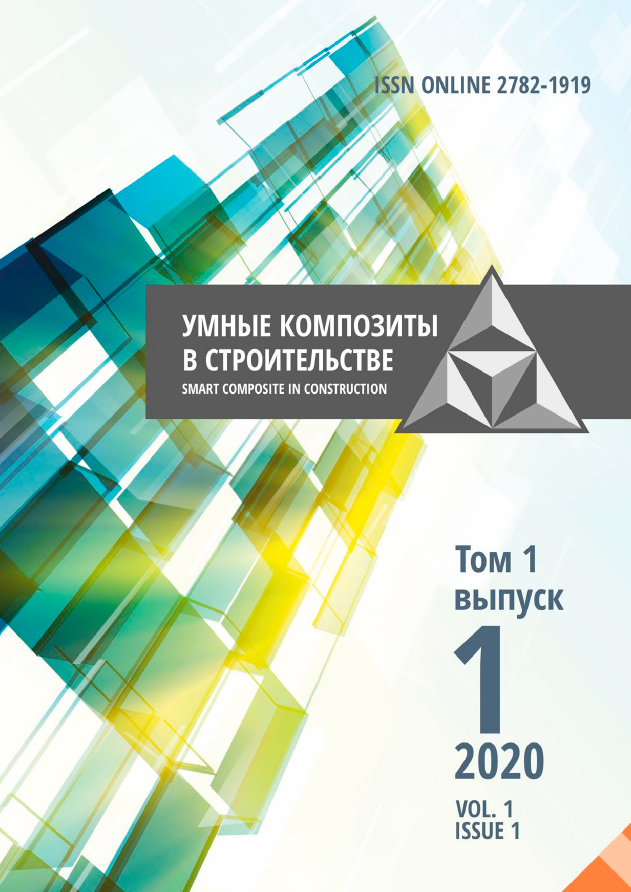employee
Nacional'nyy issledovatel'skiy Mordovskiy gosudarstvennyy universitet im. N.P. Ogareva (Department of Construction Structures, Professor)
employee
Saransk, Saransk, Russian Federation
Saransk, Saransk, Russian Federation
Saransk, Saransk, Russian Federation
Saransk, Saransk, Russian Federation
Saransk, Saransk, Russian Federation
UDC 620.17
The study deals with the kinetics of damage accumulation during exposure in a temperate climate. The research uses two types of polymer composites of significantly different climatic resistance as an example. The proposed method is the analysis of changes in the fractality index determined by the least-coverage method by tensile strain curves recorded with a high reading frequency (0.01 sec.). The fractality indices were calculated by analyzing the preceding time section that corresponds to 16 (24) experimental points, i.e., 0.16 sec. The levels of "critical" states corresponded to the minimum values of fractality indices ranged for the studied deformation curves from the beginning of loading to the level of reaching maximum tensile stresses by the specimens. The study included a field experiment on climatic aging of the studied polymers for one calendar year. We have recorded the changes in the elastic-strength characteristics of the samples after 45, 90, 180, 270 and 360 days. The results of the study showed significant differences in the damage accumulation kinetics of epoxy polymers impacted by tensile stresses, including those depending on the type of epoxy resin and hardener, as well as the duration of full-scale exposure. It was found that for climatically unstable compositions after just 180 days of climatic there is a grouping of "critical" points into ensembles similar in time, stress level, and relative elongation after stretching. At the same time, the climatic resistant polymers have a more uniform distribution of "critical" points along the deformation curves, which obviously allows them to successfully redistribute the occurring overstresses onto the workable structural elements and, consequently, to accept significantly higher levels of tensile loads and relative deformations.
epoksidnye polimery, krivye deformacii, nakoplenie povrezhdeniy, fraktal'nyy analiz, metod minimal'nogo pokrytiya
1. Selyaev V.P., Nizina T.A., Balykov A.S., Nizin D.R., Bal-balin A.V. Fractal analysis of deformation curves of fiberrein-forced fine-grained concretes under compression. PNRPU Mech. Bulletin. 2016. N 1. P. 129-146. DOI:https://doi.org/10.15593/perm.mech/2016.1.09 (in Russian).
2. Nizina T.A., Balykov A.S., Nizin D.R., Korovkin D.I. Using fractal analysis methods in studying mechanisms of deformation and destruction of nano-modified cement concretes. Int. J. Nanotechn. 2019. 16 (6/7/9/10). P. 484-495. DOI:https://doi.org/10.1504/IJNT.2019.106620
3. Nizina T.A., Selyaev V.P., Nizin D.R., Balykov A.S., Ko-rovkin D.I., Kanaeva N.S. Application of fractal analysis methods in the study of deformation mechanisms and composite building materials fracture. IOP Conf. Ser.: Mat. Sci. Eng. 2018. V 456 (1):012058. DOIhttps://doi.org/10.1088/1757-899X/456/1/012058.
4. Nizina T.A., Nizin D.R., Kanaeva N.S., Kuznetsov N.M., Artamonov D.A. Applying the Fractal Anaysis Methods for the Study of the Mechanisms of Deformation and Destruction of Polymeric Material Samples Affected by Tensile Stresses. Key engineering materials. 2019. N 799. P. 217–223. DOI:https://doi.org/10.4028/www.scientific.net/KEM.799.217.
5. Nizina T.A., Selyaev V.P., Nizin D.R., Kanaeva N.S. Quan-titative analysis of the kinetics of damage accumulation in the structure of polymer materials under tension. Construction and reconstruction. 2020. N 2. P. 77-89. DOI:https://doi.org/10.33979/2073-7416-2020-88-2-77-89 (in Russian).
6. Askadsky A.A., Matveev Yu.I. Chemical structure and physical properties of polymers. Moscow: Chemistry. 1983. 248 p. (in Russian).
7. Stukhlyak P.D., Buketov A.V., Panin S.V., Marushchak P.O., Moroz K.M., Poltaranin M.A., Vukherer T., Kornienko L.A., Lyukshin B.A. Structural levels of destruc-tion of epoxy composite materials under impact loading. Fiz. mezomekhanika. 2014. N 2. P. 65-83 (in Russian).
8. Klyushnichenko A.B., Panin S.V., Startsev O.V. Investigation of deformation and fracture at meso- and macroscale levels of reinforced plastics under static and cyclic tension. Fiz. mezomekhanika. 2002. V. 5. N 3. P.101-116 (in Russian).
9. Ivanova V.S., Balankin A.S., Bunin I.Zh., Oksogoev A.A. Synergetics and fractals in science of materials. Moscow: Nauka. 1994. 384 p. (in Russian).
10. Selyaev V.P., Kupriyashkina L.I., Neverov V.A., Selyaev P.V. Fractal models of destruction of concretes. Reg. architec-ture and construction. 2015. N 1. P. 11-22 (in Russian).
11. Selyaev V.P., Bezrukova E.S., Kechutkina E.L., Selyaev V.V. Statistical model of discrete-continuous (quantum) mechanism of fractal structure destruction of cement compo-sites. Durability of building materials, products and struc-tures: mat. Rus. sci. techn. conf. Saransk: Izd-vo Mord. un-ta. 2019. P. 308-317 (in Russain).
12. Travush V.I., Selyaev V.P., Selyaev P.V., Kechutkina E.L. On the possible quantum nature of the deformation and frac-ture of composites. Industr.and civil construction. 2016. N 9. P. 94-101 (in Russian).
13. Nizina T.A., Selyaev V.P., Nizin D.R., Artamonov D.A, Kanaeva N.S. Fractal analysis of deformation curves of epoxy polymers under tention. Polymers in construction. 2019. N 1. P. 48-57 (in Russian).
14. Dubovikov M.M., Starchenko N.S. Variation index and its applications to analysis of fractal structures. Sci. Alm. Gordon. 2003. N 1. P. 1-30.
15. Dubovikov M.M., Starchenko N.S., Dubovikov M.S. Di-mension of the minimal cover and fractal analysis of time series. Physica A. 2004. N 339. P. 591-608. DOIhttps://doi.org/10.1016/j.physa.2004.03.025.
16. Zaitsev Yu.V. Modelling of deformation and strength of the concrete by methods fracture mechanics. Moscow: Stroyizdat.1982. 196 p. (in Russian).







